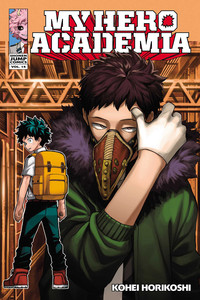Review
by Nick Creamer,My Hero Academia
GN 14
| Synopsis: |  |
||
It's just one impossible trial after another for Midoriya and his classmates. Having escaped their provisional license exams largely unscathed, they're soon presented with a new challenge: work study programs, where prospective heroes fight alongside pros not as protected interns, but as true equals. And here to introduce these work study programs are U.A. Academy's “Big Three,” the renowned third years known as the very best U.A. has to offer. In spite of all he and his friends have accomplished, Midoriya is still far away from achieving his goal - and soon he'll be in for even more trouble, when he meets up with All Might's former sidekick! |
|||
| Review: | |||
Something has felt fundamentally different about My Hero Academia for these last few volumes. Though All Might's bout with One For All was certainly consequential in an in-world sense, the repercussions of that fight have also expressed themselves through a variety of tonal and structural changes. My Hero Academia's world feels larger now, as the mechanics underlying its superpowered society come into focus, and the path towards “becoming the greatest hero ever” seems ever less clear. And yet, in spite of this drifting focus, these chapters possess a vitality and sense of immediacy that makes them as thrilling as they are surprising, as beloved characters cast about for certainty in a shifting world. Volume fourteen opens with an explosive articulation of that uncertainty, as we conclude the sparring match between Midoriya and Bakugo. The first wonder of this volume is Horikoshi's gorgeous articulation of the violence of this fight, with the volume of Bakugo's explosions and intensity of Midoriya's dashes each articulated in ferocious detail. From the imposing character introduction spreads to the brutal fight scenes, it feels like Horikoshi's ever-impressive art skills have improved even more recently, matching his visual ambition. His shading, billowing explosions, and expressive hands deserve particular recognition, but even though this volume lacks any imposing central fight, it's still a buffet of visual riches in most regards. But right, that Bakugo-Midoriya fight. As I was saying, even though we've seen these two fight before, the growing complexity and uncertainty of their places in this world lends this particular clash a unique sense of intimacy. In its aftermath, Bakugo doesn't just slink away with a scowl - he actually admits to his frustrations and insecurities regarding Midoriya's destiny, and is consoled by All Might. Later on, this greater mutual trust leads to a moment when Midoriya honestly asks Bakugo what he thought of his recent tactical innovations, and Bakugo honestly answers with some constructive criticism. Though the solidity of the world around these characters may be fraying, they themselves are rising to that challenge by growing as people, resulting in a more realistic and engaging story in all regards. After that fight, the rest of this volume is mostly taken up by new introductions, as Midoriya and his classmates meet U.A.'s top students, new villains emerge from the shadows, and Midoriya ultimately secures an interview with All Might's former sidekick. Number one U.A. student Mirio Togata easily steals the show here, dazzling through a combination of incredibly unique visual design, generally engaging personality, and combat spectacle. Like All Might, Mirio's design feels pulled from an entirely different visual tradition from the rest of this manga - I mean, he's basically Swole Tintin. And yet, as with All Might, Horikoshi is able to drag tremendous personality out of that unexpected design, making for a character who feels indispensable just a few chapters after he first appears. The new fragility of My Hero Academia's world isn't just clear on the heroes' side - it also sets the context for Shigaraki's big scene, where his team makes contact with an ex-yakuza splinter group led by their own charismatic killer. The divergent goals of the various League of Villain members have always added a nice dash of complexity to this world's villains, and this sequence doubles down on that strength, ending in a bloody clash between fundamentally unlike antagonists. In a world protected by All Might, it almost felt like no one could actually die; sequences like this seem designed to tell us that that world has passed, and now no one is safe. From its bombastic character introductions to its gorgeous visual setpieces, this volume of My Hero Academia persistently demonstrates Horikoshi's brilliance as both artist and storyteller. In place of Midoriya's initially narrow dreams, we've now been presented with a convoluted and deeply precarious world, where divergent ideals of justice clash and even the villains can't trust each other. You could call it unfocused, but I'm personally thrilled by the broad horizons of My Hero Academia's current trajectory, and eager to see where Horikoshi takes these pieces next. My Hero Academia is a dazzling juggernaut, and I'm happy to marvel at its course. |
| Grade: | |||
|
Overall : A
Story : A-
Art : A
+ Highly entertaining volume stuffed with exciting character introductions and gorgeous visual set pieces |
|||
| discuss this in the forum (1 post) | | |||
| Production Info: | ||
|
Full encyclopedia details about Release information about |
||